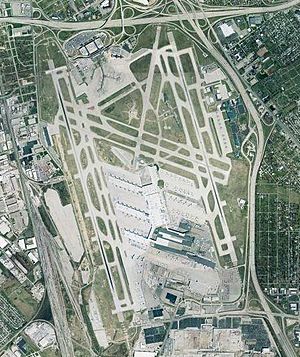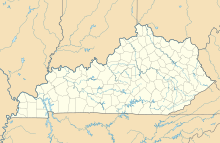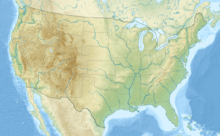Louisville International Airport facts for kids
Quick facts for kids
Louisville Muhammad Ali International Airport
Standiford Field
|
|||||||||||||||||||
|---|---|---|---|---|---|---|---|---|---|---|---|---|---|---|---|---|---|---|---|
 |
|||||||||||||||||||
 |
|||||||||||||||||||
| Summary | |||||||||||||||||||
| Airport type | Public | ||||||||||||||||||
| Owner/Operator | Louisville Regional Airport Authority (LRAA) | ||||||||||||||||||
| Serves | Louisville, Kentucky | ||||||||||||||||||
| Hub for | UPS Airlines | ||||||||||||||||||
| Elevation AMSL | 501 ft / 153 m | ||||||||||||||||||
| Coordinates | 38°10′27″N 085°44′11″W / 38.17417°N 85.73639°W | ||||||||||||||||||
| Map | |||||||||||||||||||
| Runway | |||||||||||||||||||
|
|||||||||||||||||||
| Statistics (2019) | |||||||||||||||||||
|
|||||||||||||||||||
|
Sources: FAA, RITA/BTS, Airport website
|
|||||||||||||||||||
Louisville Muhammad Ali International Airport (SDF) is a major airport in Louisville, Kentucky. It's located in Jefferson County, Kentucky. The airport covers about 1,500 acres (6.1 square kilometers) and has three runways. Its airport code, SDF, comes from its old name, Standiford Field.
Even though it doesn't have regular international passenger flights, it's a "port of entry." This means it handles many international cargo flights. In 2019, over 4.2 million passengers used the airport. More than 5.7 billion pounds (2.89 million tons) of cargo also passed through it. This makes it the second-busiest airport in the U.S. for cargo. It's also the fourth-busiest in the world for cargo traffic.
The airport is home to Worldport. This is the main worldwide hub for UPS Airlines. The Kentucky Air National Guard also uses the airport. They fly C-130 transport planes from their base here.
On January 16, 2019, the airport's name was changed. It was renamed Louisville Muhammad Ali International Airport. This was done to honor the famous boxer and Louisville native, Muhammad Ali. On June 6, 2019, the airport showed off its new logo. It features Ali's silhouette with his arms raised in victory. A butterfly shape is in the background.
Contents
History of the Airport
Building Standiford Field
The airport was first built in 1941 by the United States Army Corps of Engineers. They chose a spot south of Louisville. This land had not flooded during the big Ohio River flood of 1937. The airport was named Standiford Field. It honored Elisha David Standiford, a local businessman. He was involved in transportation and owned some of the land.
The Army controlled the field until 1947. Then, it was given to the Louisville Air Board. This allowed it to be used for commercial flights. Before 1947, Bowman Field was Louisville's main airport.
Early Days and Growth
For many years, passengers used a small brick building called the Lee Terminal. Today's much larger airport facilities were built in the 1980s. Most of the old Lee Terminal was later taken down.
When Standiford Field opened to the public in 1947, all commercial flights moved there. Airlines like American, Eastern, and TWA started flying from here. They served about 1,300 passengers each week. At first, the airlines used old World War II barracks. A proper terminal opened on May 25, 1950. The Lee Terminal could handle 150,000 passengers a year. It had 6 new gates and much more space.
In 1970, the terminal got bigger again. The main lobby was extended. A new concourse for Delta Air Lines was built.
Modern Airport Improvements
In the 1980s, plans for a new terminal began. This was part of the Louisville Airport Improvement Plan (LAIP). Construction started on a new terminal building. It cost $35 million and could handle almost 2 million passengers by 1985. New parallel runways were also built. These were needed for the growing UPS operations. Most of these improvements were finished in the 1990s. The airport was completely updated.
During the 1990s, Southwest Airlines started flying to the airport. This helped the number of passengers grow by almost 100 percent. In 1995, the airport's name changed from Standiford Field to Louisville International Airport. Around that time, two new parallel runways opened. Runway 17L/35R is 8,578 feet (2,615 meters) long. Runway 17R/35L is 11,887 feet (3,623 meters) long. Both are 150 feet (46 meters) wide.
The Kentucky Air National Guard moved its base to the airport. A new UPS air mail facility was added. New hangars for corporate planes and a new control tower were also built. In 2005, a $26 million renovation of the terminal was finished.
On January 16, 2019, the airport was officially renamed Louisville Muhammad Ali International Airport. This honored the boxing legend, who was a Louisville native.
Today, about 1.9 million passengers board flights here each year. This number is expected to grow. Several airlines serve Louisville International. These include Allegiant, American, Delta, Frontier, Southwest, United Express, FedEx, and UPS.
Airport Facilities
Aircraft Operations
In the year ending May 31, 2019, the airport had 170,876 aircraft operations. This means about 468 planes took off or landed each day. Most of these (77%) were airline flights. About 15% were air taxis, 7% were general aviation, and 1% were military flights. At that time, 29 aircraft were based at the airport.
Terminal Building
The Jerry E. Abramson Terminal is the main building for passenger flights. It has two floors. The first floor has ground transportation and baggage claim. The second floor has ticketing, passenger drop-off, and access to the concourses.
There are 23 gates in two concourses:
- Concourse A has 12 gates.
- Concourse B has 11 gates.
These concourses are connected by a round area called a rotunda. This area also has the main security checkpoint.
Runways
Louisville Muhammad Ali International Airport has three concrete runways. Two of them are parallel to each other. One runway crosses the others. The westernmost runway (17R/35L) is the longest. It is 11,887 feet (3,623 meters) long. It was made longer in 2007. This allows larger planes to fly nonstop to places as far away as Asia.
Cargo Hub: Worldport
Worldport is the huge worldwide air hub for UPS. It is located at the Louisville Muhammad Ali International Airport. UPS has had a hub in Louisville since 1980. But the name "Worldport" wasn't used officially until 2002. This was after a $1 billion, five-year expansion.
This facility is massive. It is 5.2 million square feet (48 hectares), which is like 80 football fields! It can handle 115 packages every second. That's 416,000 packages per hour. UPS is one of the biggest employers in Louisville and Kentucky. More than 20,000 people work at Worldport. This facility handles express and international packages and letters. It serves all of UPS's major international and domestic hubs.
In 2006, a 1 million square foot expansion was finished. This helped to include heavy freight into the UPS system. In May 2006, UPS announced another big expansion. They planned to invest another $1 billion. This second expansion was completed in April 2010. The facility now measures 5.2 million square feet. Its outer edge is 7.2 miles (11.6 kilometers) long. The plan was to add over 1 million square feet. Also, 334,500 square feet (31,080 square meters) of space would be updated with new technology. Worldport's sorting ability was set to grow. It would go from 300,000 packages per hour to 416,000 packages per hour.
Airlines and Destinations
Passenger Flights
| Airlines | Destinations | Refs |
|---|---|---|
| Allegiant Air | Fort Lauderdale, Las Vegas, Orlando/Sanford, Punta Gorda (FL), St. Petersburg/Clearwater Seasonal: Charleston (SC) (begins May 28, 2021), Destin/Fort Walton Beach, Myrtle Beach, New Orleans, Sarasota, Savannah |
|
| American Airlines | Charlotte, Dallas/Fort Worth | |
| American Eagle | Charlotte, Chicago–O'Hare, Dallas/Fort Worth, Miami, New York–LaGuardia, Philadelphia, Washington–National | |
| Delta Air Lines | Atlanta | |
| Delta Connection | Detroit, Minneapolis/St. Paul, New York–LaGuardia | |
| Frontier Airlines | Denver Seasonal: Orlando |
|
| Southwest Airlines | Atlanta, Baltimore, Chicago–Midway, Dallas–Love, Denver, Houston–Hobby, Las Vegas, Orlando, Phoenix–Sky Harbor, Tampa Seasonal: Fort Myers |
|
| United Express | Chicago–O'Hare, Denver, Houston–Intercontinental, Newark, Washington–Dulles |
Cargo Flights
| Airlines | Destinations |
|---|---|
| Air Cargo Carriers | Charleston (WV), Decatur, Madison, Warsaw (IN), Traverse City (MI) |
| Ameriflight | Huntsville, Knoxville, Moline/Quad Cities, Smyrna (TN), South Bend |
| FedEx Express | Cincinnati, Greensboro, Memphis, Roanoke |
| SkyLink Express | Hamilton (ON) |
| UPS Airlines | Albany (GA), Albany (NY), Albuquerque, Anchorage, Atlanta, Austin, Baltimore, Billings, Birmingham (AL), Bogotá, Boise, Boston, Buffalo, Burbank, Casablanca, Cedar Rapids, Charlotte, Chicago–O'Hare, Cleveland, Cologne/Bonn, Columbia (SC), Columbus–Rickenbacker, Dallas/Fort Worth, Denver, Des Moines, Detroit, Dubai, East Midlands, Fargo, Fort Lauderdale, Fort Myers, Fort Wayne, Gary/Chicago, Greensboro, Greenville/Spartanburg, Hamilton (ON), Harrisburg, Hartford, Hong Kong, Honolulu, Houston–Intercontinental, Jackson (MS), Jacksonville, Kansas City, Knoxville, Lafayette, Lansing, Las Vegas, Little Rock, Long Beach, Los Angeles, Manchester (NH), McAllen, Memphis, Mexico City, Miami, Milwaukee, Minneapolis/St. Paul, Montréal–Mirabel, Newark, Newburgh, New Orleans, New York–JFK, Oakland, Oklahoma City, Omaha, Ontario, Orange County (CA), Orlando, Peoria, Philadelphia, Phoenix–Sky Harbor, Pittsburgh, Portland, Providence, Raleigh/Durham, Richmond, Sacramento–Mather, St. Louis, Salt Lake City, San Antonio, San Bernardino, San Diego, San Jose (CA), San Juan, Seattle–Boeing, Seoul–Incheon, Shanghai–Pudong, Sioux Falls, Springfield (MO), Syracuse, Tampa, Tokyo–Narita, Toronto–Pearson, Tulsa, Vancouver, Campinas–Viracopos, Washington–Dulles, West Palm Beach |
Airport Statistics
Top Domestic Destinations
Here are the busiest domestic routes from Louisville Muhammad Ali International Airport. This data is from November 2019 to October 2020.
| Rank | City | Passengers | Carriers |
|---|---|---|---|
| 1 | Atlanta, Georgia | 159,430 | Delta, Southwest |
| 2 | Charlotte, North Carolina | 90,340 | American |
| 3 | Dallas/Fort Worth, Texas | 81,540 | American |
| 4 | Chicago–O'Hare, Illinois | 80,140 | American, United |
| 5 | Chicago–Midway, Illinois | 59,350 | Southwest |
| 6 | Baltimore, Maryland | 53,640 | Southwest |
| 7 | Denver, Colorado | 49,320 | Frontier, Southwest, United |
| 8 | Orlando, Florida | 43,890 | Frontier, Southwest |
| 9 | Detroit, Michigan | 32,520 | Delta |
| 10 | Houston–Intercontinental, Texas | 28,310 | United |
This table shows which airlines carry the most passengers at SDF. This data is from September 2019 to August 2020.
| Rank | Airline | Passengers | Share |
|---|---|---|---|
| 1 | Southwest Airlines | 656,000 | 26.74% |
| 2 | Republic Airways | 404,000 | 16.47% |
| 3 | Delta Air Lines | 390,000 | 15.89% |
| 4 | Mesa Airlines | 177,000 | 7.23% |
| 5 | Allegiant Air | 170,000 | 6.91% |
| 6 | Other | 656,000 | 26.75% |
Annual Passenger Traffic
Here's how many passengers have used SDF each year.
| Year | Passengers | Year | Passengers |
|---|---|---|---|
| 2003 | 3,291,586 | 2013 | 3,404,080 |
| 2004 | 3,399,712 | 2014 | 3,355,811 |
| 2005 | 3,696,524 | 2015 | 3,359,472 |
| 2006 | 3,637,795 | 2016 | 3,346,545 |
| 2007 | 3,812,299 | 2017 | 3,474,340 |
| 2008 | 3,678,919 | 2018 | 3,866,057 |
| 2009 | 3,254,657 | 2019 | 4,239,064 |
| 2010 | 3,343,968 | 2020 | 1,113,692 |
| 2011 | 3,392,745 | 2021 | |
| 2012 | 3,365,115 | 2022 |
See also
 In Spanish: Aeropuerto Internacional de Louisville para niños
In Spanish: Aeropuerto Internacional de Louisville para niños




